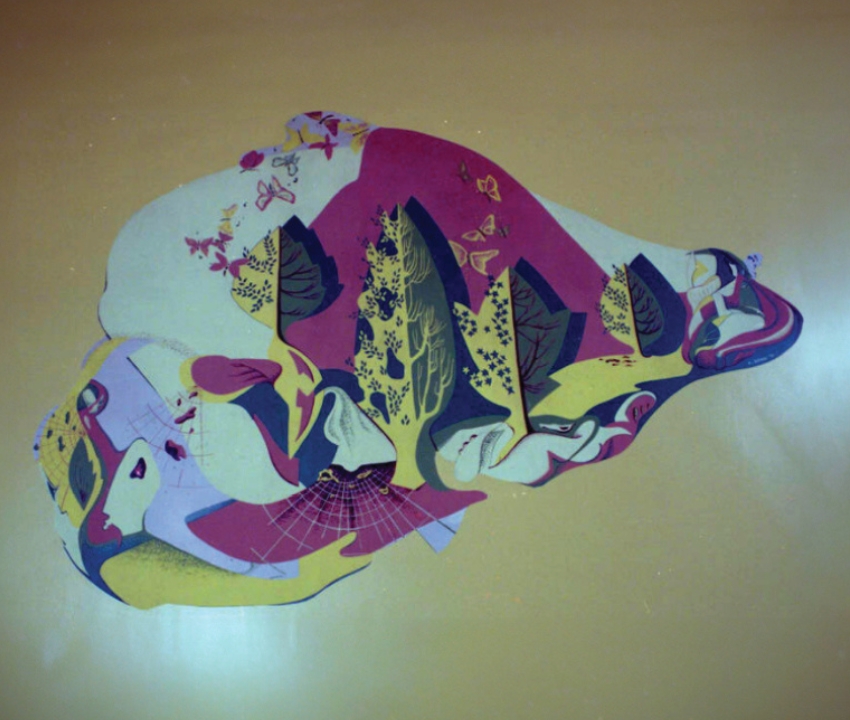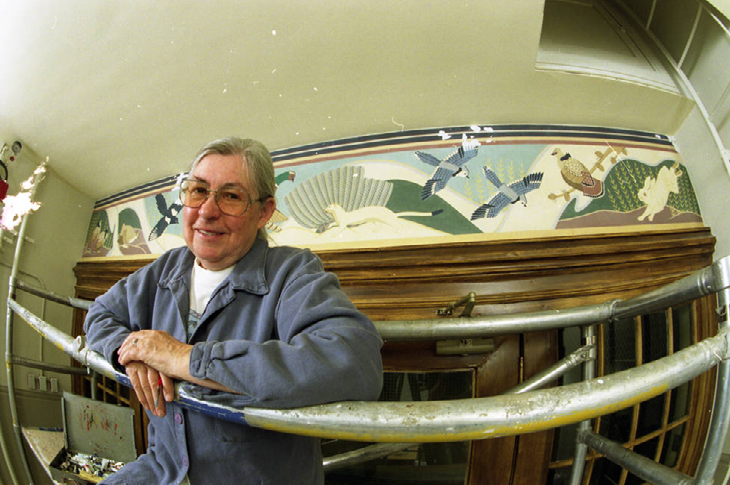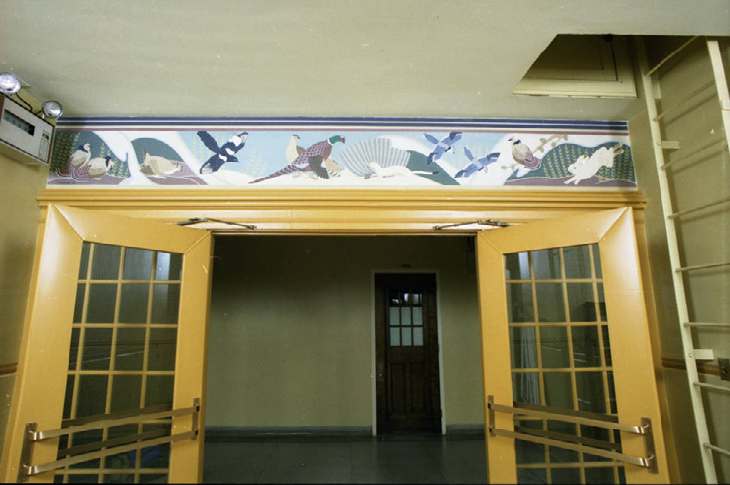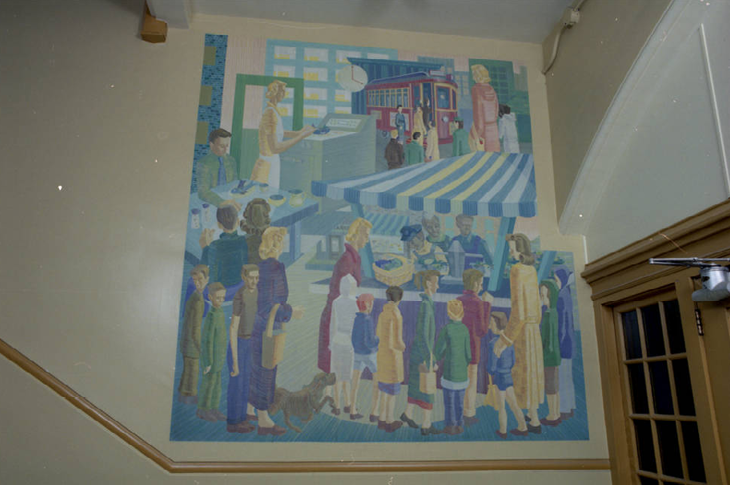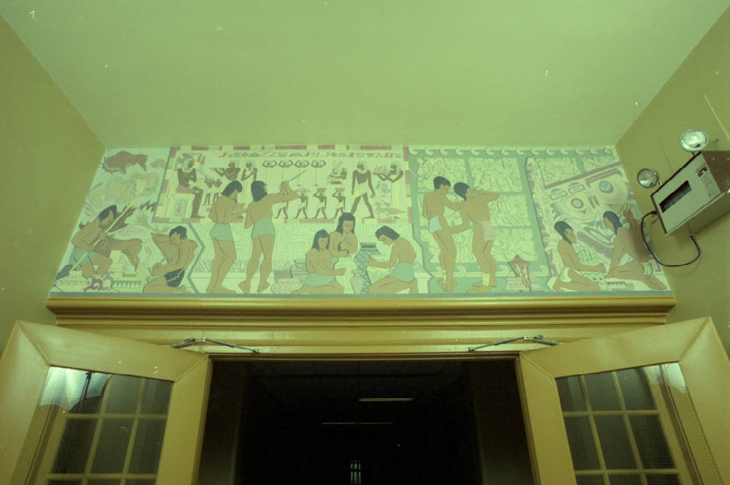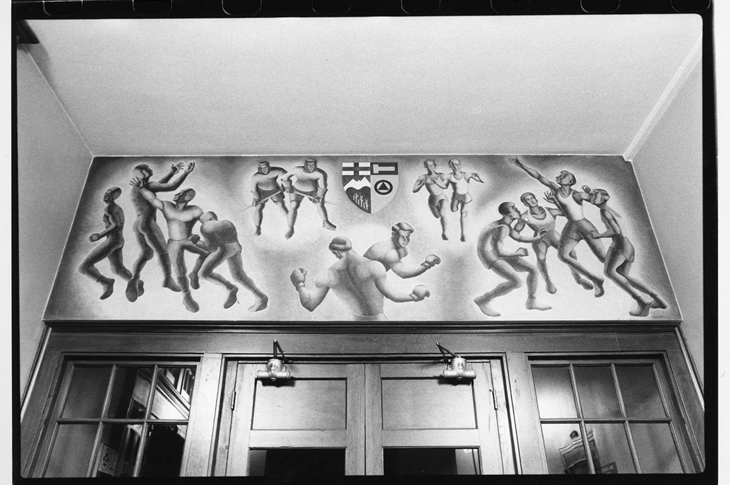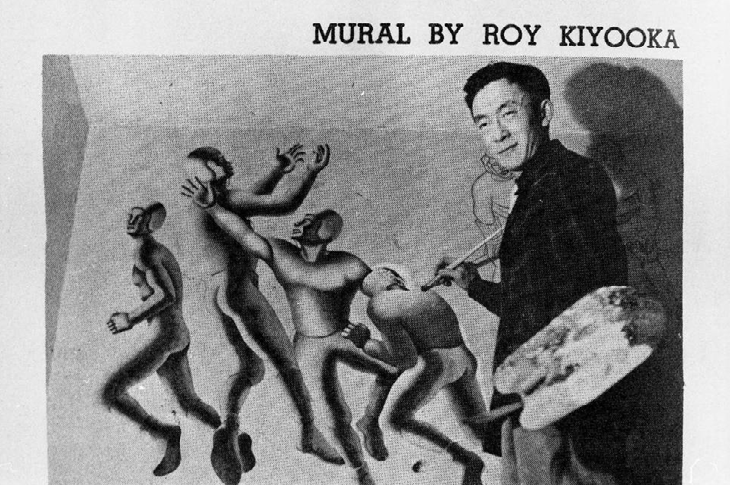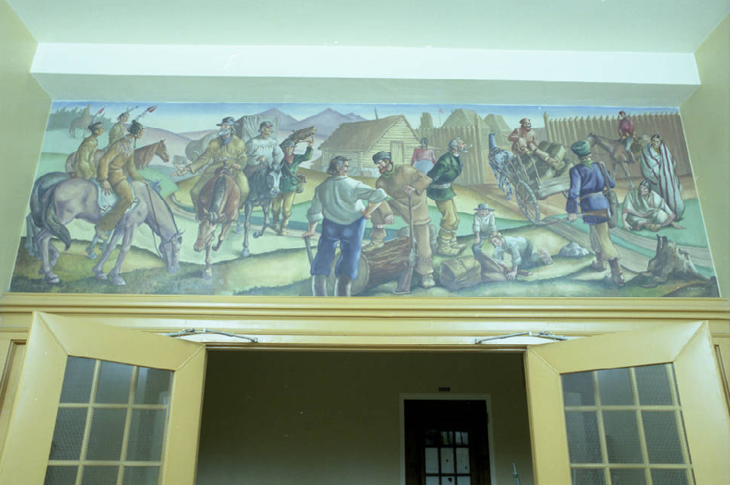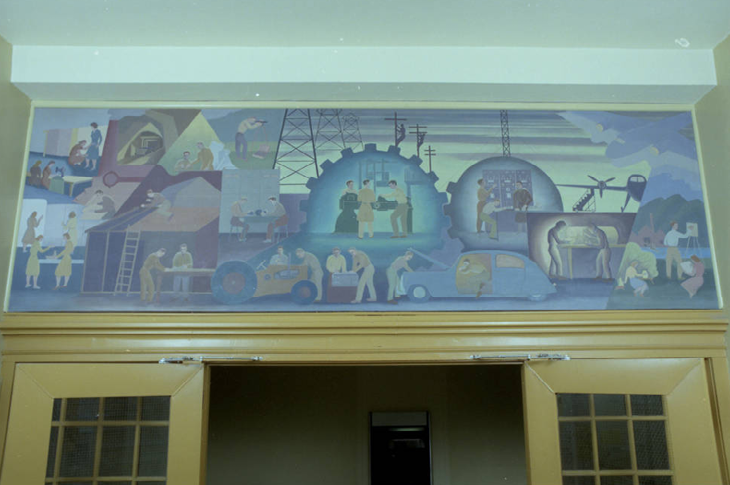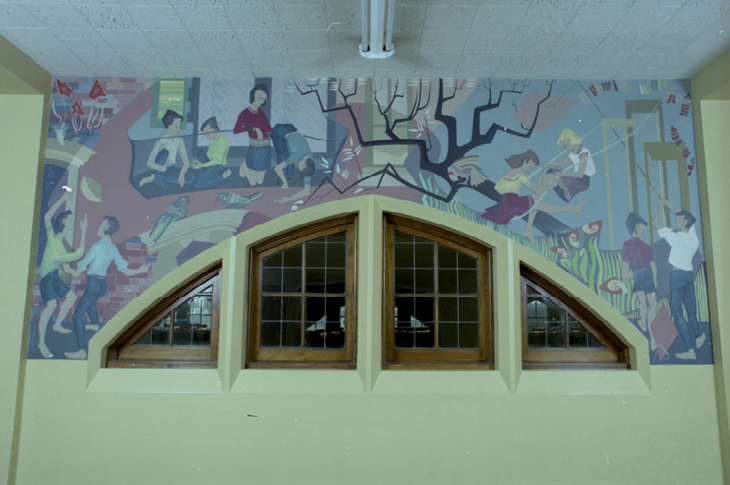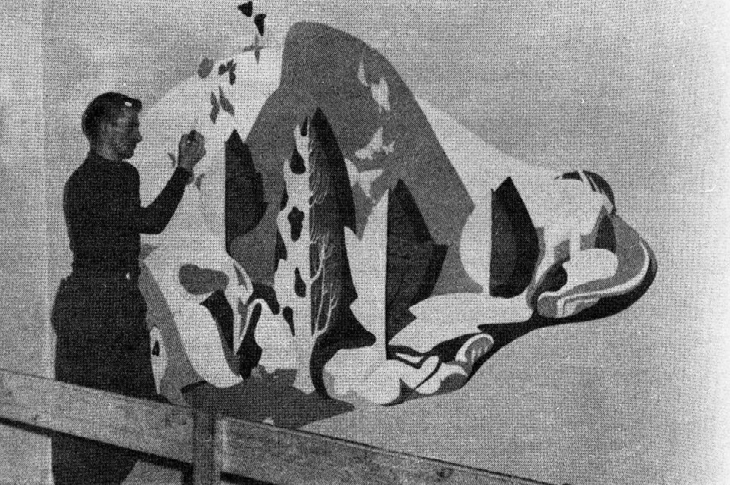About this episode
Calgary’s first public art project was by students from the Art Department of the Provincial Institute of Technology and Art (PITA, as SAIT was known at the time). Their murals can still be seen and admired on the walls of Heritage Hall today. The ambitious program was created by the head of the department, Illingworth “Buck” Kerr, in 1949 and included works by nearly a dozen students including Gertrude Hudson, Ron (Gyo-Zo) Spickett, Roy Kiyooka and Ted Godwin. Discover the vital role PITA’s Art Department played in developing the arts in Calgary, and hear how Heritage Hall became a canvas, a gallery and a platform for many artists in the early days of their careers.
Listen as art historian Lisa Christensen sets the Heritage Hall murals in historical context, and as renowned Canadian sculptor Katie Ohe (Art ‘58) shares memories of the lifelong impact studying at PITA has had on her art.
(Intro) DR. DAVID ROSS
What is possible with a steadfast and bold vision. Welcome, welcome to SAIT!
(0:15) FEMALE SPEAKER: A red brick and sandstone building looms large on Calgary's north hill, complete with twin towers, Gothic arches, and gargoyles. They've stood watch over the city for a hundred years. Now, this is Heritage Hall, the heart of the Southern Alberta Institute of Technology known as SAIT and we are celebrating the lessons of the past 100 hundred years since students first walked through its doors. One hundred years of innovation, pushing boundaries and leading by example. One hundred years of getting SAIT students up to speed for a rapidly changing new world. Join us and learn from the stories whispered from these walls celebrating 100 years of Heritage Hall. What lessons would we learn if only these halls could talk?
(1:10) RON TARRANT: Simply put…War is catastrophic yet somehow from the ashes of devastation, some found the spark of inspiration. Like a flower flourishing amid darkness, World War II brought us classic literature, poetry and music. Postwar found its own stimulus in the form of peace and at the Provincial Institute of Technology and Art —what we now know as SAIT. Peace brought an ambitious public art project from Buck Kerr in the form of sprawling murals on the walls of Heritage Hall, featuring distinguished artists, Gertrude Hudson, Ron (Gyo-zo) Spickett and Roy Kiyooka. These masters of murals asked why hang your art on the wall when the wall can become your art. And this is how Heritage Hall became a gallery, a canvas and a platform for many legendary local artists.
(2:11) LISA CHRISTENSEN: The character of the artist is unavoidably stamped on every original work because of the intangibles, only you can make the artist.
I'm Lisa Christensen, and I am a lifelong citizen of the city of Calgary and have been involved in the art world here for over 30 years. And so that in itself ties me directly to SAIT because the art world in many ways began in Calgary, in the halls of Tech, in the classes that were run there. And the artists that started their careers there.
I had seen the murals in Heritage Hall, out of the corner of my eye when either attending things at SAIT, going to exhibitions there, meeting with students there, I was from the other side, I was from the University of Calgary and there was a little bit of friendly rivalry between the SAIT students and the U of C students when I was in school. So that was my first introduction to them was just seeing them in passing. And honestly, I never really paid too much attention to them until I started to understand some of those names and what those names meant in Calgary's art world.
I think they surprised me because they were related to a much larger world than my world was at the time. Those murals talk about classical themes, they talk about industry, they talk about history and they look very much forward towards the future. And as a young student, I just was very focused on the here and now what I was doing in the eighties, painting was king. And that's what we were all focused on. And then it was modern painting and it was abstract painting. And it didn't really relate to anything other than what came from you as a student, we didn't look back to the classics and we didn't look forward in the way that art history has traditionally.
So, as I said, I was a student over at U of C. And at the time that I was there, Harry Kiyooka was teaching drawing. And I was in his life drawing class for two or possibly three years. And he was probably the first teacher that I had, who I came to realize was an important artist in the city of Calgary. Because, you know, when you go to university, you show up, you go to your classes, you see the exhibitions, you have your critiques, and then you start to circulate around in the community a bit. And Harry was the first one for me that really made me realize that I was, I was into something special. And then of course there was Katie Ohe’s fantastic zipper sculpture that was in the concourse of the building that I was in the earth sciences building, where the arts classes were. And I would walk by it and spin it every day. And I started to look around me and I started to see art on the walls and extruded cement in the Brutalist architecture of Calgary. And I started to realize that I was in an incredible place with these instructors who were, who were living it, who were actually working as successful artists in the community.
(5:01)KATIE OHE: My name is Katie Ohe. I had always hoped to go to art school and this was a fresh and a new experience. I was entering into a life dream. That's what brought me to Calgary in 1954.
I arrived at the doors of the brick building.
Going into the building, seeing a lot of the previous art students and instructor art on the walls of SAIT of the art department. It was very, very overwhelming and it had a lifelong impact on me.
Exhibition was so overwhelming. I thought I wasn't good enough. I waited around and automatically put myself in line to register. Once I knew that I was in behind the desk, I was in. Anyone that practiced art, we would know about them. And of course, the instructors, they were very informative. And I think most of the artists in Calgary were really embodied in the art department at SAIT. This would include Illingworth Kerr, Marion Nicoll, Luke Lindoe, and there were others. At that time, the department was small. We could have had five or six instructors.
(6:28) LISA CHRISTENSEN: Illingworth Kerr was one in a line of very important heads of the Art Department at SAIT. It began with A. C. Leighton and Lars Haukaness who came from the Canadian Pacific Railway and went on into H. G. Glyde and Jock Macdonald and Illingworth Kerr. So, he was one of that group of people who were sought out to head a very prestigious program and who had very solid training and a good career already behind them at that point in their lives. They were expected not only to teach, but to drive the program and to be an example in the community of what an accomplished artist was all about.
(7:06) KATIE OHE: I imagined I would be a painter or a drawer. I had no concept of becoming a sculptor and it was Marion Nicholl and Luke Lindoe, that sort steered me into my own strength.
(7:23) LISA CHRISTENSEN: SAIT and the provincial Institute's art programs were incredibly important. Calgary was in such a time, a wonderful time of postwar positivity and economic boom because of, you know, the Leduc strike was in 1947. And so, Calgary was transitioning from being kind of an agricultural, almost rural based city to a financial center and to have art as a part of that, and to have a program that taught the practicalities of art. So, the working part of art, how to stretch canvas, how to prepare a wall, how to create commercial designs to be used. Ron Spickett went on to work for the Hudson's Bay and their commercial art department in Calgary for a while. And that was very much part of the art world. So, I think they, they were incredibly important in building the infrastructure for an artistic part of our city.
(8:16) KATIE OHE: I think my strongest impression was really of the faculty. In my mind, they were really the ‘Super Kings of art’. They were accomplished artists. The first impression of Marion Nicholl for me was to say, “Ooh, that's what an artist looks like”. They're very confident in what they were.
(8:39) LISA CHRISTENSEN: From the very of the mural program, when it had received all the various approvals that it needed. And Roy Kiyooka and Ron Spickett were beginning. This would've been in February of 1949, that they started to paint their murals on the walls. And the language of the time was very flowery and Calgary comes through in these quotes as having an incredible sense of pride and students wandering through while these murals were being done. A quote was gleaned from one of them that said, “No doubt in time, tech will rival this Sistine Chapel”. It doesn't rival the Sistine Chapel, but the optimism of that quote and the sense of possibility in that quote, I think is just completely fantastic and gives us an idea of the spirit in the city in those years.
(8:29) KATIE OHE: There are painting drawings, anything that had to do with regular courses. Also, in the main hallway, they had an exhibit of instructor works and graduate from the college. This was the artwork that I encountered when I first stepped into the art space. I recall a sculpture by Luke Lindoe, it was a bird. And I recall thinking this is amazing. It was pretty overwhelming experiencing that piece of sculpture. So, I think that told me something about my own inclinations. I also recall drawings, a lot of nude figure drawings and then landscape paintings.
(10:20) LISA CHRISTENSEN: Spickett at the beginning and Ted Godwin at the end in 1955 in looking at those murals, which are, you know, it's easy to walk by them. But if you look at these two artists now who are of such stature, and you look at those murals, that would've happened at the very beginning of their careers, you can see this inkling of what is to come in Spickett’s figures and the horses and the horse and rider series that he would later become so famous for. And with Godwin in the colors and that application of brushwork that he’s, he's known for. And even though they were really held rather tightly, but by the reins of their requirements of the murals, they, they were to be flat. There was not to be any realism or any depth in them at all. You can still see in that first and that last student's work glimmerings of what was to come. And I think that's a really nice kind of bookend around that whole mural project.
(11:14) RON TARRANT: Continue the journey through SAIT's historical past visit sait.ca/alumni for more episodes.
Listen now
Photo gallery
Photographs courtesy of SAIT Archives.
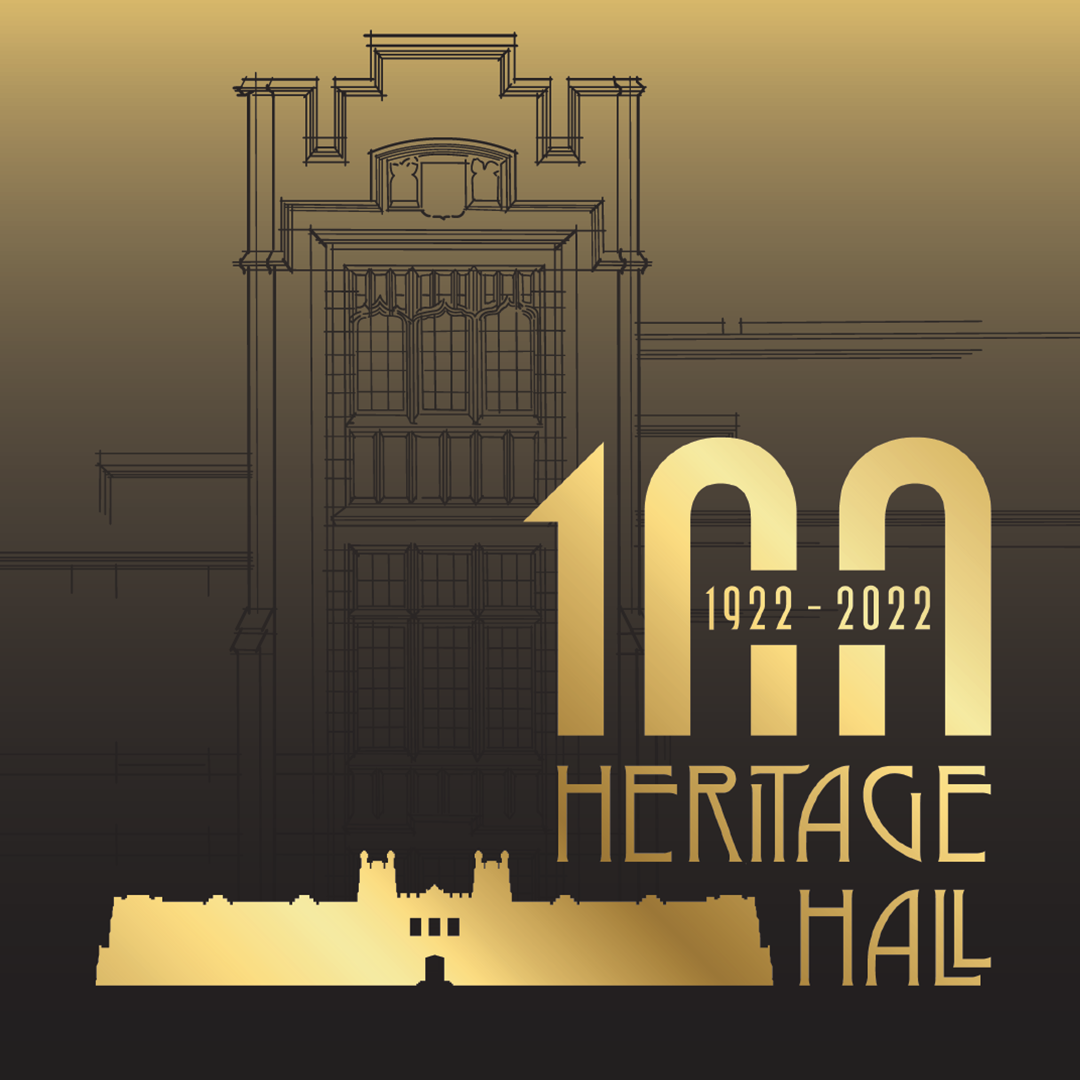
Celebrating 100 years of history
To commemorate the first 100 years of the iconic Heritage Hall building, we released an intriguing eight-episode audio series and dedicated the Spring 2022 issue of LINK magazine that share the memories and stories from SAIT alumni, employees and neighbours.

Oki, Âba wathtech, Danit'ada, Tawnshi, Hello.
SAIT is located on the traditional territories of the Niitsitapi (Blackfoot) and the people of Treaty 7 which includes the Siksika, the Piikani, the Kainai, the Tsuut’ina and the Îyârhe Nakoda of Bearspaw, Chiniki and Goodstoney.
We are situated in an area the Blackfoot tribes traditionally called Moh’kinsstis, where the Bow River meets the Elbow River. We now call it the city of Calgary, which is also home to the Métis Nation of Alberta.
